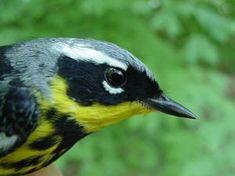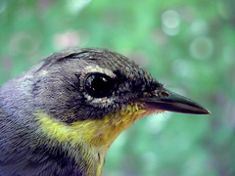HOME: www.hiltonpond.org |
|||
|
THIS WEEK at HILTON POND Back to Preceding Week; on to Next Week |
|
THE KING OF SNAKES While watching feeder birds this week at Hilton Pond Center, we noticed a movement at the edge of a gutter just above the observation window of the old farmhouse. We figured it to be one of our ubiquitous Eastern Gray Squirrels on one of its countless jaunts across the roof, but it was soon obvious that a serpent was making its way along the gutter. 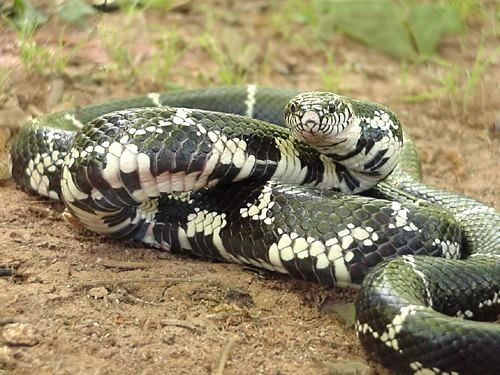 All text & photos © Hilton Pond Center A couple of Black Ratsnakes regularly climb the Flowering Dogwood trees that grow close to the farmhouse, and often they glide onto the roof on their way to hunting forays in the attic. (We're guessing that's why we never seem to hear the pitter-patter of little mouse feet overhead!) As the snake hung over the gutter, we noticed the first ten-inch segment of its body was the same width throughout; since ratsnakes have relatively wide heads and narrower necks, we now knew this was something different. While we watched, the snake continued to extend its body past the gutter's edge, eventually losing its grip on the smooth metal and falling about six feet to the wooden deck below. As soon as it hit the decking--unhurt by the quick descent--it was obvious that our new guest was serpentine royalty: a four-foot-long Common (or Eastern) Kingsnake, Lampropeltis getula. Kingsnakes take their name from their ability to dominate other serpents; in fact, they eat them. The kingsnake apparently is immune to the bite of our North American pit vipers ( Common Kingsnakes are non-venomous and often fail to bite when first encountered, so we didn't hesitate to grab our visitor on the deck to study and photograph it. As we reached for the kingsnake, it vibrated its tail rapidly--a common response that reaches perfection among the rattlesnakes. This scare tactic didn't deter us, and we grasped the kingsnake tightly behind its head. With just as firm a grip, it wrapped its strong, sinewy body around our hand--probably not an attempt to constrict and kill us but rather to provide stability in an unfamiliar situation.
This odoriferous material emanates from the snake's cloaca--the single opening through which solid and liquid wastes and reproductive cells must pass. In the photo at above left, the cloaca is the pinkish area on the snake's undersurface; normally the opening isn't nearly as obvious because it is sealed tight by scales that surround it. The cloaca also serves as a line of demarcation that helps one know whether a snake is poisonous or not--at least in North America. Except for its pungent cloacal fluid, the Common Kingsnake we caught at Hilton Pond Center was quite dry, but it was almost slick to the touch; unlike rough-skinned snakes, the kingsnake's scales are unkeeled and smooth as glass (above right). This may be an adaptation that allows the kingsnake to glide more easily through small holes as it searches for prey. We imagine such hole-crawling happens a lot in the life of an Common Kingsnake, since individuals are known to live nearly 30 years and reach lengths of almost six feet. After taking our close-up photos, we placed the kingsnake on the ground, where it formed into a tight ball (below left). This behavior may be another defensive mechanism, or may simply be the safest thing to do until the snake gets its bearings; it even stayed in a ball temporarily when we rolled it over on its back to photograph the ventral side (below right). Incidentally, the yellow-white markings on the dorsal surface of the serpent reveals why the Common Kingsnake is sometimes called "Chain Snake." Common Kingsnakes occur in more temperate regions of the U.S. from coast to coast, but the seven subspecies have very different markings or lack them altogether. A related species, the secretive Mole Kingsnake, L. calligaster, occurs in the Carolina Piedmont, as does the Scarlet Kingsnake, L. triangulum--famous as a mimic of the Eastern Coral Snake. (The Scarlet Kingsnake also occurs in a brown form that is more often called the Eastern Milk Snake.) 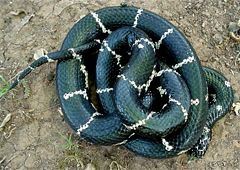 . .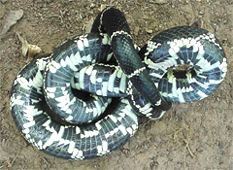 Back on the ground, our Common Kingsnake finally got oriented and--perhaps tired of our handling--assumed a strike posture. We zoomed out a little with the camera's telephoto attachment and dropped low to get a snake's eye view (see top photo). The serpent lunged toward us a few times, but thanks to the telephoto and our surprisingly quick reflexes, it never quite got all the way to the camera lens. As we finished our photo work and backed away, the kingsnake sensed an opening and slithered off into nearby shrubbery. We hope our "king of snakes" doesn't go very far and that it remembers how it got onto the farmhouse roof; you never know when the ratsnakes might go on strike and require us to call in the kingsnake clan to keep the small rodent population under control at Hilton Pond Center. All text & photos © Hilton Pond Center Comments or questions about this week's installment? NOTE: Be sure to scroll down for an account of all birds banded or recaptured during the week, as well as some other interesting nature notes. "This Week at Hilton Pond" is written & photographed You may wish to consult our Index of all nature topics covered since February 2000. You can also use the on-line Search Engine at the bottom of this page. For a free, non-fattening, on-line subscription to "This Week at Hilton Pond," just send us an E-mail with SUBSCRIBE in the Subject line. Please be sure to configure your spam filter to accept E-mails from hiltonpond.org. |


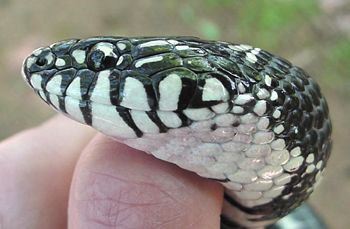 Copperheads, Water Moccasins, and rattlesnakes)--as well as that of Eastern Coral Snakes--and seems to have no trouble swallowing these elongated prey items even when they're a little longer than the kingsnake itself. Kingsnakes are constrictors, so they typically suffocate their prey before dining, whether they be birds, mammals, lizards, frogs, turtle eggs, or just about any vertebrate small enough for the kingsnake to ingest.
Copperheads, Water Moccasins, and rattlesnakes)--as well as that of Eastern Coral Snakes--and seems to have no trouble swallowing these elongated prey items even when they're a little longer than the kingsnake itself. Kingsnakes are constrictors, so they typically suffocate their prey before dining, whether they be birds, mammals, lizards, frogs, turtle eggs, or just about any vertebrate small enough for the kingsnake to ingest.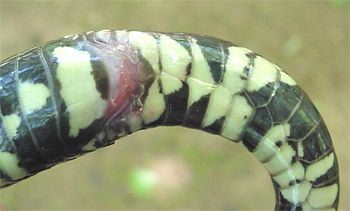 The snake's next ploy was not unexpected, but it was unpleasant: out spewed a semi-liquid substance that undoubtedly is one of the vilest odors in nature. The smell--a mixture of musk and urine and feces--is indescribable, but once it has graced your olfactory nerves, you will never forget it. You also will wash your hands several times with perfumed soap after handling any snake that so anoints you. Most potential snake-eaters--including unnatural ones such as dogs and cats--are inclined to release any snake that "vents its spleen," especially if the predator gets a sudden mouthful.
The snake's next ploy was not unexpected, but it was unpleasant: out spewed a semi-liquid substance that undoubtedly is one of the vilest odors in nature. The smell--a mixture of musk and urine and feces--is indescribable, but once it has graced your olfactory nerves, you will never forget it. You also will wash your hands several times with perfumed soap after handling any snake that so anoints you. Most potential snake-eaters--including unnatural ones such as dogs and cats--are inclined to release any snake that "vents its spleen," especially if the predator gets a sudden mouthful.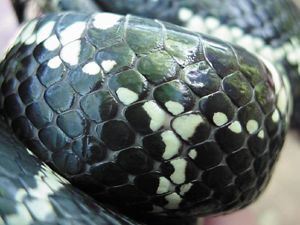 On our non-poisonous snakes, all the ventral scales posterior to the cloaca (i.e., those to the cloaca's right in the photo)--are double, while those ahead of it are single; in the poisonous pit vipers, all the belly scales are single, from head to tail tip. We don't recommend that you go around lifting snakes by their tails to see if they might be poisonous, but this tidbit of information may help put your mind at ease when you wonder whether any dead snakes brought in by Rover or Fluffy were venomous. (Caveat: The venomous Eastern Coral Snake has a double row of caudal scales, but this species doesn't occur in the Piedmont.)
On our non-poisonous snakes, all the ventral scales posterior to the cloaca (i.e., those to the cloaca's right in the photo)--are double, while those ahead of it are single; in the poisonous pit vipers, all the belly scales are single, from head to tail tip. We don't recommend that you go around lifting snakes by their tails to see if they might be poisonous, but this tidbit of information may help put your mind at ease when you wonder whether any dead snakes brought in by Rover or Fluffy were venomous. (Caveat: The venomous Eastern Coral Snake has a double row of caudal scales, but this species doesn't occur in the Piedmont.)

